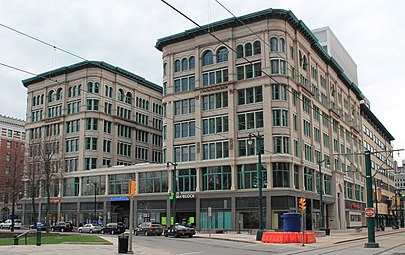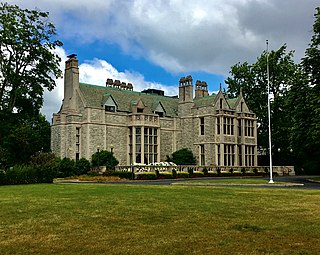Architecture of Buffalo, New York
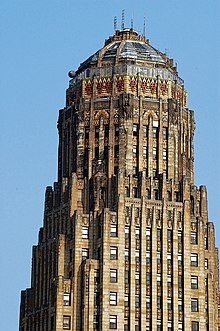

The Architecture of Buffalo, New York, particularly the buildings constructed between the American Civil War and the Great Depression, is said to have created a new, distinctly American form of architecture and to have influenced design throughout the world.[1]
History
Buffalo's original plan from the early 19th century was loosely based on Pierre Charles L'Enfant's 1791 plan for Washington, an Americanized version of Paris's system of radiating boulevards. Buffalo's radial street grid was designed by Joseph Ellicott and complemented by a system of parks and parkways designed by Frederick Law Olmsted. Buffalo was the first city for which Olmsted designed an interconnected park and parkway system rather than stand-alone parks.
During the
According to The New York Times architecture writer Nicolai Ourousoff:
Buffalo was founded on a rich tradition of architectural experimentation. The architects who worked here were among the first to break with European traditions to create an aesthetic of their own, rooted in American ideals about individualism, commerce and social mobility.[1]
The city contains buildings designed by American architecture masters like Frank Lloyd Wright, Louis Sullivan, and Henry Hobson Richardson, making Buffalo one of the most architecturally significant cities in America. It also contains many buildings designed by modern architects including Minoru Yamasaki, Toshiko Mori, Marcel Breuer[3] and Harrison & Abramovitz.
Tallest buildings
| Rank | Building | Height feet/meters |
Floors | Year |
|---|---|---|---|---|
| 1 | One Seneca Center
|
529 / 161 | 40 | 1972 |
| 2 | Buffalo City Hall | 398 / 121 | 32 | 1931 |
| 3 | Rand Building | 391 / 119 | 29 | 1929 |
| 4 | Main Place Tower | 350 / 107 | 26 | 1969 |
| 5 | Liberty Building | 345 / 105 | 23 | 1945 |
| 6 | One M&T Plaza | 317 / 97 | 21 | 1966 |
| 7 | Electric Tower | 294 / 90 | 14 | 1912 |
| 8 | St. Paul's Cathedral | 275 / 84 | N/A | 1851 |
| 9 | 50 Fountain Plaza | 275 / 84 | 17 | 1990 |
| 10 | Buffalo Central Terminal | 271 / 83 | 20 | 1929 |
Notable architects
Numerous architects and landscape architects have constructed landmark buildings and park systems of varying styles in Buffalo. They include:
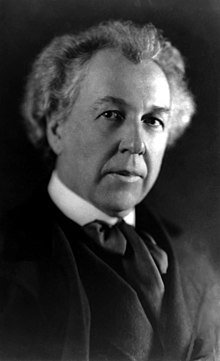
- Max Abramovitz
- Dankmar Adler
- Charles N. Agree
- Frederick C. Backus
- Milton Earl Beebe
- Louise Blanchard Bethune
- Alfred Bossom
- Gordon Bunshaft
- Daniel Burnham
- John E. Brent
- Robert T. Coles
- Marcel Breuer
- Carrère and Hastings
- George Cary (architect)
- Joseph Ellicott
- Cyrus L. W. Eidlitz
- James A. Johnson
- Esenwein & Johnson
- Philip M. Jullien
- Edward Brodhead Green
- Alfred T. Fellheimer
- Gwathmey Siegel & Associates Architects
- Wallace Harrison
- Albert Kahn
- Edward Austin Kent
- Kohn Pedersen Fox
- Lockwood, Greene & Co.
- Lord & Burnham
- Duane Lyman
- George Washington Maher
- McKim, Mead & White
- George Jacob Metzger
- Toshiko Mori
- Robert North
- Frederick Law Olmsted
- George B. Post
- Cyrus Kinne Porter
- Cornelius Ward Rapp
- George Leslie Rapp
- Henry Hobson Richardson
- Paul Marvin Rudolph
- Eliel Saarinen
- Eero Saarinen
- Ellen Biddle Shipman
- Joseph Lyman Silsbee
- Edward Durell Stone
- Louis Sullivan
- Skidmore, Owings & Merrill
- Max Toltz
- Richard Upjohn
- Calvert Vaux
- Stanford White
- Frank Lloyd Wright
- Minoru Yamasaki
Landmarks, monuments and public places

Albright–Knox Art Gallery
The
Buffalo Central Terminal
The
Buffalo City Court Building
The
Buffalo City Hall
Buffalo History Museum
Buffalo Main Light
The Buffalo Main Light, also known as The Buffalo Lighthouse, is Buffalo's oldest building. It was built in 1833 and deactivated in 1914. It appears on the city seal at the mouth of the Buffalo River. It is also one of the oldest lighthouses on the Great Lakes. The walls of the tapered, unpainted octagonal limestone tower are four feet thick at the base and rise to 44 feet in height. The foundation material was stone molehead and the lighthouse was constructed out of limestone and cast iron. The shape of the tower was octagonal and was 60 feet (18 m) high. The lens installed in 1857 was a third order Fresnel lens.[7] It was listed on the National Register of Historic Places in 1984.
Delaware Park System
Larkin Administration Building
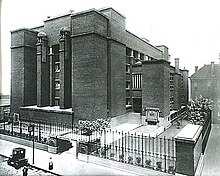
The Larkin Administration Building was Frank Lloyd Wright's first commission in Buffalo. Larkin executive Darwin D. Martin hired Wright to design a building that would house the large number of clerks needed to operate the mail-order business for the Larkin Soap Company. Because the building would be located in an industrial part of town, it was necessary to make the building as attractive as possible to women, who made up the bulk of the white collar work force.[8]
The Larkin building was Wright's first commercial commission
The Larkin Company went out of business in 1937, and the building was sold. Eventually, the City of Buffalo took it over for back taxes planning to demolish it for a trucking plaza. Despite community outcry, the building was torn down in 1950.
Old Post Office
Prudential (Guaranty) Building
The
Richardson Olmsted Complex
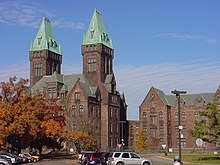
The Richardson Olmsted Complex is a grouping of Medina red sandstone and brick hospital buildings designed in 1870 in the Kirkbride Plan by architect Henry Hobson Richardson with grounds by landscape architect Frederick Law Olmsted. The complex was the largest commission of Richardson's career and marks the beginning of his characteristic "Romanesque Revival" style known as "Richardsonian Romanesque." It was added to the National Register of Historic Places on January 12, 1973, and designated a National Historic Landmark on June 24, 1986.
Sculptures and monuments
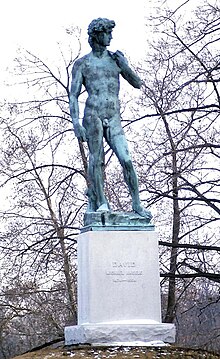
There are several sculptures and monuments located throughout the city, including:
- Michelangelo's David by Angelus and Sons (founder)[13]
- George W. Keller (Architect), M. J. Powers (Founder)[14]
- McKinley Monument by Alexander Phimister Proctor (Sculptor), Newman & Evans (Sculptor), Carrère and Hastings (Architect)[15]
- Wolfgang A. Mozart by Olin H. Warner (Sculptor), Bureau Brothers Foundry (Founder)[16]
- Alexander Petofi (Sandor Petofi) by Geza Kende (Sculptor; Original Bust), Gabriella F. Koszorus-Varsa (Sculptor; New Bust), Frank A. Spangenberg (Sculptor; Base)[17]
- John F. Kennedy bust by Bryant Baker[18]
- Giuseppe Verdi by Antonio Ugo (Sculptor), A. Decianno (Sculptor)[19]
- Frederic Chopin by Jozef Mazur[20]
- Frank X. Schwab by C. Sorgi[21]
- Indian Hunter by John Quincy Adams Ward[22]
- General Daniel Davidson Bidwell by Sahl Swarz[23]
- Commodore Oliver Hazard Perry by Charles Henry Niehaus[24]
Residential
Birge-Horton House
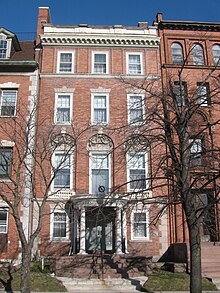
The
Charles W. Goodyear House
The Charles W. Goodyear House was designed by Buffalo architect Edward Green, of the Buffalo architecture firm Green & Wicks, and was completed in 1903 at a cost of $500,000 (equivalent to $16,956,000 in 2023). The home was built for Charles and Ella Goodyear. The house is located in the Delaware Avenue Historic District, a federally designated historic district listed on the National Register of Historic Places since 1974. The exterior of the 2+1⁄2-story house is brick trimmed with stone. The mansard roof includes a row of dormers with pedimented tops with a festooned motif that runs along the roofline above a dentilled cornice. The principal entrance is on the north (right) side of the house denoted by a large arched doorway, bordered on each side by stone urns. The east façade facing Delaware Avenue has a one-story porch with columns, that was later bricked in.[26]
Darwin D. Martin House
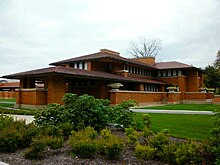
The
Theodore Roosevelt Inaugural National Historic Site
The Theodore Roosevelt Inaugural National Historic Site, also known as the Ansley Wilcox House, at 641 Delaware Avenue was built in 1840 by George Cary (U.S. Army) originally intended as the Barrack's officer's quarters. After the post was disbanded in 1845, the home reverted to a private residence. Subsequent owners continued to modify the structure adding and demolishing out structures and additions. In the late 19th century, Dexter Rumsey gave the property to his son-in-law Ansley Wilcox and his wife Mary Grace Rumsey. The newest inhabitants made extensive renovations to the structure.
In 1901, while attending the
William Dorsheimer House
The William Dorsheimer House was designed and built in 1868 by Henry Hobson Richardson (1838–1886) for William Dorsheimer (1832–1888), a prominent local lawyer and Lieutenant Governor of New York. It is located on Delaware Avenue in Buffalo and is a 2+1⁄2-story brick dwelling. It represents the profound influence of French ideas on the arts in the post Civil War period.[28] It was listed on the National Register of Historic Places in 1980.
William R. Heath House
The
Gallery
-
Buffalo Athletic Club
-
Brisbane Building
-
Gates Vascular Institute - Kaleida Health
-
Old Post Office or "U.S. Post Office"
-
Ansley Wilcox House
-
Williams-Butler House by McKim, Mead & White
-
The old Adam's Mark Hotel, reopened in 2018 as the Buffalo Grand Hotel
Timeline of notable buildings
Before 1900:
- 1833 Buffalo Main Light
- 1840 Ansley Wilcox House, George Cary
- 1849–1851 St. Paul's Cathedral, Richard Upjohn
- 1868 William Dorsheimer House, Henry Hobson Richardson
- 1870 Richardson Olmsted Complex, Henry Hobson Richardson and Frederick Law Olmsted
- 1871 Delaware Avenue Methodist Episcopal Church, John Selkirk; 2000–2006, renovation to Babeville Flynn Battaglia
- 1871 County and City Hall, Andrew Warner
- 1882 Metcalfe House, McKim, Mead & White (Demolished, 1980)
- 1889 St. Louis Roman Catholic Church, Schikel and Ditmar
- 1890–1893 Erie County Savings Bank, George B. Post (Demolished, 1968)
- 1890–1905 Skidmore, Owings and Merrill architect Gordon Bunshaft
- 1894 Green & Wicks
- 1894 Robert Root House, Stanford White of McKim, Mead & White (Demolished, 1935)
- 1895 Birge-Horton House, Green and Wicks
- 1895–1896 Williams-Pratt House, Stanford White of McKim, Mead & White
- 1896 Prudential (Guaranty) Building, Louis Sullivan and Dankmar Adler
- 1896 Ellicott Square Building, Daniel Burnham
- 1896–1898 Williams-Butler House/Jacobs Executive Development Center, Stanford White of McKim, Mead & White
- 1897 Office of the Supervising Architect during the tenure of Jeremiah O'Rourke
1900–1920:
- 1900 Buffalo and Erie County Botanical Gardens, Lord & Burnham
- 1901 Green & Wicks
- 1901 Buffalo History Museum, George Cary
- 1901 Temple of Music, Esenwein & Johnson (Demolished, 1902)
- 1901–1902 Green & Wicks
- 1902–1911 Hotel Lafayette, Bethune, Bethune & Fuchs; 1916–1917 and 1924–1926 additions, Esenwein & Johnson
- 1903 Charles W. Goodyear House, Edward Brodhead Green
- 1903–1904 George Barton House, Frank Lloyd Wright
- 1903–1905 Darwin D. Martin House, Frank Lloyd Wright
- 1903–1906 Larkin Administration Building, Frank Lloyd Wright (Demolished, 1950)
- 1904–1905 William R. Heath House, Frank Lloyd Wright
- 1906 The Calumet, Esenwein & Johnson
- 1908 Walter V. Davidson House, Frank Lloyd Wright
- 1911–1912 Larkin Terminal Warehouse, Lockwood, Greene & Co.
- 1912 City Honors School or Fosdick-Masten Park High School, Esenwein & Johnson
- 1912 Electric Tower, Esenwein & Johnson and E.B. Green and Sons
- 1912 Harlow C. Curtiss Building, Paul F. Mann
- 1913 Green & Wicks
- 1914–1915 South Park High School, Edward Brodhead Green
- 1915 Concrete-Central Elevator, H.R. Wait and Monarch Engineering Co.
1920–1939:
- 1922 Saturn Club, Bley & Lyman
- 1923 Hotel Statler or Statler City, George B. Post & Sons
- 1924 M. Wile and Company Factory Building, Esenwein & Johnson
- 1925 Cargill Pool Elevator, C. D. Howe and Monarch Engineering Co.
- 1925 Alfred C. Bossom; 1961 addition Lyman & Associates
- 1926 Shea's Performing Arts Center, Rapp and Rapp
- 1926 The Huyler Building, Harvey Starin Horton
- 1929 Fellheimer & Wagner
- 1929 Buffalo Museum of Science, Esenwein & Johnson
- 1929 Rand Building, James W. Kideney & Associates; Franklyn and William Kidd
- 1931 Buffalo City Hall, Dietel, Wade & Jones
- 1934 Edwin M. and Emily S. Johnston House, Bley & Lyman
- 1936 Michael J. Dillon Memorial United States Courthouse, E.B. Green and Sons and Bley & Lyman
- 1938 Erie County Holding Center, Green & James
- 1938–1940 Kleinhans Music Hall, Eliel Saarinen and Eero Saarinen
- 1939–1940 Buffalo Memorial Auditorium, Green & James
1940 to the present:
- 1964–1966 One M&T Plaza, Minoru Yamasaki and Lyman Associates
- 1969 Main Place Tower, Harrison & Abramovitz
- 1969–1972 One Seneca Tower, Skidmore, Owings & Merrill
- 1973 The Avant; 2009 renovation, Stieglitz Snyder Architecture
- 1974 Buffalo City Court Building, Pfohl, Roberts and Biggie
- 1987 HOK Sport
- 1990 50 Fountain Plaza, Brisbin Brook Beynon Architects
- 2004 Blue Sky Mausoleum, Anthony Puttnam of Taliesin Associated Architects from Frank Lloyd Wright design, 1935
- 2007–2011 Robert H. Jackson United States Courthouse, Kohn Pedersen Fox
- 2009 Eleanor and Wilson Greatbatch Pavilion, Toshiko Mori
- 2012 Gates Vascular Institute, Mehrdad Yazdani of CannonDesign
- 2014–2015 Diamond and Schmitt Architects
Styles and schools
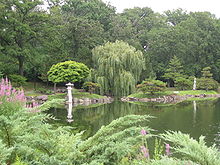
Buffalo architects used many design styles and belonged to a variety of architectural schools. Below is a sample of some of the styles and schools and schools found in Buffalo architecture:
- Art Deco
- Art Nouveau
- Brutalism
- Châteauesque
- Federal Style
- Gothic Revival
- Greek Revival
- Italianate
- Second Empire
- Sullivanesque
- Victorian
- Queen Anne
See also
- Buffalo, New York
- National Register of Historic Places listings in Buffalo, New York
- List of National Historic Landmarks in New York
- List of tallest buildings in Buffalo, New York
References
- ^ a b nytimes.com Nicolai Ourousoff, "Saving Buffalo's Untold Beauty", The New York Times, November 14, 2006.
- ISBN 978-1-62534-006-1.
- ^ "UB Buildings: Bell Hall". www.buffalo.edu. Retrieved February 24, 2017.
- ^ "History of the Buffalo Central Terminal". buffalocentralterminal.org. Retrieved August 31, 2015.
- ^ LaChiusa, Chuck. "City Court Building".
- ^ Schihl, James; Healy, James. "City Hall History". City of Buffalo. Tony DiNatale. Archived from the original on August 12, 2015. Retrieved August 31, 2015.
- ^ "Buildings & Monuments". visitbuffaloniagara.com. Retrieved October 9, 2015.
- ^ PBS website
- ^ Terra Stories
- ^ T. Robins Brown (n.d.). "National Register of Historic Places Registration: U.S. Post Office". New York State Office of Parks, Recreation and Historic Preservation. Retrieved July 25, 2009. See also: "Accompanying three photos".
- ^ "Old Post Office". SkyscraperPage.com. Retrieved December 25, 2007.
- ^ "Old Post Office". Emporis.com. Archived from the original on March 21, 2007. Retrieved December 25, 2007.
- ^ "DAVID". ci.buffalo.ny.us. Retrieved October 9, 2015.
- ^ "SOLDIERS AND SAILORS MONUMENT". ci.buffalo.ny.us. Retrieved October 9, 2015.
- ^ "WILLIAM MCKINLEY MONUMENT". ci.buffalo.ny.us. Retrieved October 9, 2015.
- ^ "WOLFGANG A. MOZART". ci.buffalo.ny.us. Retrieved October 9, 2015.
- ^ "ALEXANDER PETOFI". ci.buffalo.ny.us. Retrieved October 9, 2015.
- ^ "JOHN F. KENNEDY". ci.buffalo.ny.us. Retrieved October 9, 2015.
- ^ "GIUSEPPE VERDI (ORIGINAL)". ci.buffalo.ny.us. Retrieved October 9, 2015.
- ^ "FREDERIC CHOPIN". ci.buffalo.ny.us. Retrieved October 9, 2015.
- ^ "FRANK X. SCHWAB". ci.buffalo.ny.us. Retrieved October 9, 2015.
- ^ "Indian Hunter". ci.buffalo.ny.us. Retrieved October 9, 2015.
- ^ "General Daniel Davidson Bidwell". ci.buffalo.ny.us. Retrieved October 9, 2015.
- ^ "Commodore Oliver Hazard Perry". ci.buffalo.ny.us. Retrieved October 9, 2015.
- ^ Claire L. Ross (January 26, 2004). "National Register of Historic Places Registration: Birge--Horton House". New York State Office of Parks, Recreation and Historic Preservation. Retrieved June 14, 2009. See also: "Accompanying four photos".
- ^ "Delaware Avenue Historic District". livingplaces.com. Retrieved September 9, 2015.
- ^ Darwin D. Martin House website
- ^ Francis Kowsky (April 10, 1980). "National Register of Historic Places Registration: William Dorsheimer House". New York State Office of Parks, Recreation and Historic Preservation. Retrieved June 14, 2009. See also: "Accompanying seven photos".
- ^ a b Reyner Banham & Francis R. Kowsky, Buffalo Architecture, pp. 163–164, Buffalo Architectural Guidebook Corporation; 1981.
- ^ Edgar Tafel, Years with Frank Lloyd Wright: Apprentice to Genius, p. 84, Courier Dover Publications; 1985.
- ^ Brendan Gill, Many Masks, pp. 145–146, Da Capo Press; 1998.
External links
- Built in Buffalo: How to Research Local Architecture: A page of online and offline sources for documenting houses, factories, churches and other Buffalo buildings
- Buffalo Architecture and History: A comprehensive website documenting many of Buffalo's historical structures.
- Buffalo Architectural Plans and Drawings: A guide to surviving architectural plans and drawings for Buffalo houses and buildings of all kinds.
- Major Architectural History Sources,: A guide to researching a Buffalo building by the Buffalo History Museum






